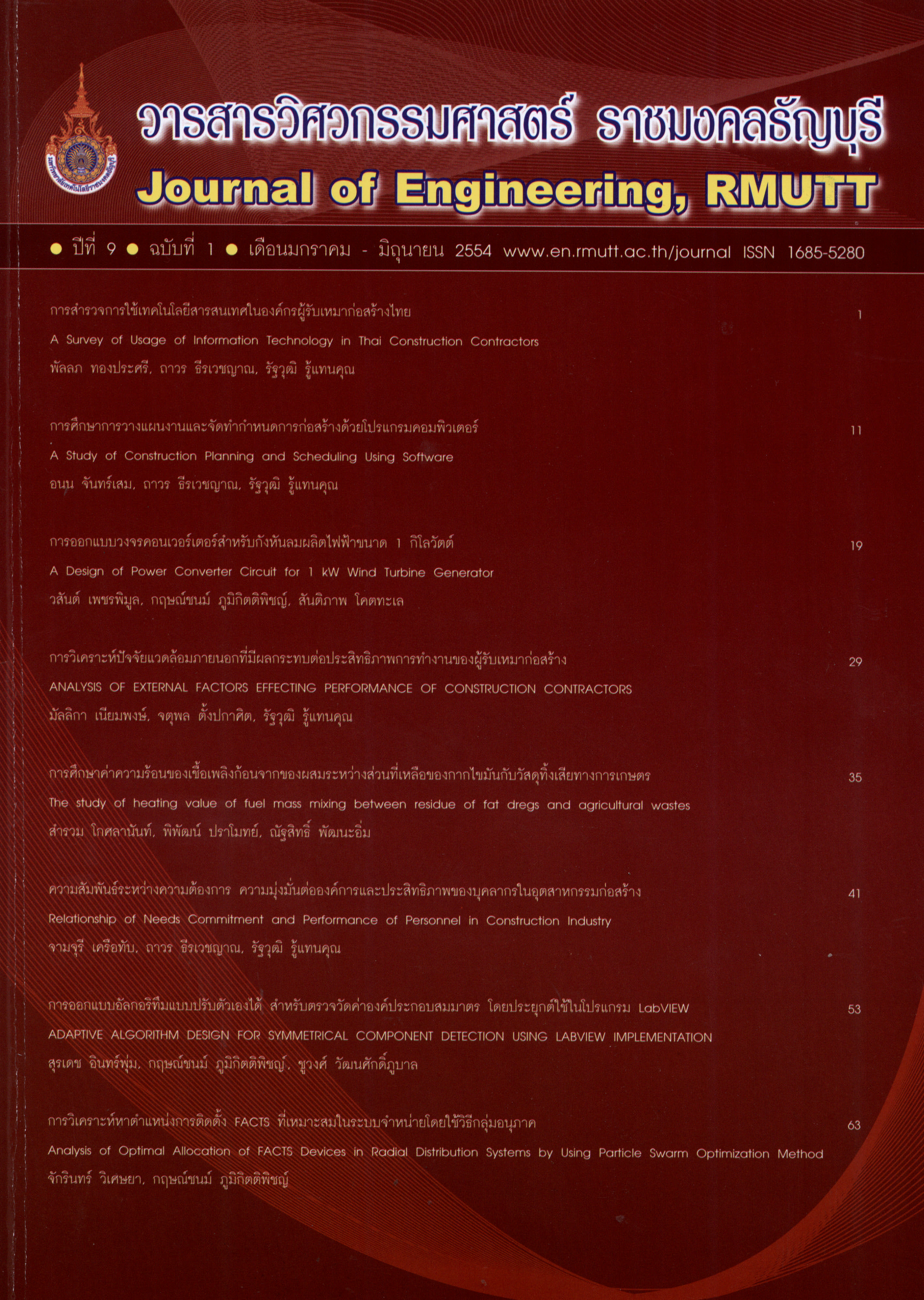Analysis of Optimal Allocation of FACTS Devices in Radial Distribution Systems by Using Particle Swarm Optimization Method
Main Article Content
Abstract
This paper proposes the analysis of optimal allocation analysis of FACTS devices using particle swarm optimization method (PSO). FACTS device is the compensation device that can inject the real and active power into the power system in order to improve the voltage stability and power system reliability. The analysis uses the IEEE 33 buses radial distribution system (RDS) for testing system. The total real and reactive power is 3.72 MW and 2.3 MVar, respectively and uses Base MVA is 10 MVA and Base kV is 12.66 kV. The original real and reactive power loss is 221.4346 kW and 150.1784 RVar, respectively. The load flow analysis on distribution use backward-forward sweep methodology and optimization technique by using PSO method. The simulation results show that the original voltage at bus I is 0.98 p.u.. The weak bus is occurred at bus 33 0.881317 p.u.. After used the optimization technique, the size of SVC and STATCOM with 2.4431 MVA and 2.4939 MVA, respectively, The power loss is the installed at bus 12 decreased and the voltage bus is increased. The comparison between SVC and STATCOM installation, SVC have aspect appropriate more installed STATCOM. Aspect weak decreased real and reactive power loss 27.54% and 43.17%. STATCOM decreased real and reactive power loss to 27.12% and 41.60%. This paper results show solve the voltage stability of power system after installed SVC and STATCOM. The guideline to support the development of energy technology in the future.
Article Details
The manuscript, information, content, picture and so forth which were published on Frontiers in engineering innovation research has been a copyright of this journal only. There is not allow anyone or any organize to duplicate all content or some document for unethical publication.
References
Y. Fukuyama, Y. Nakanishi, and H. D. Chiang, 1996."Fast Distribution Power Flow Using MultiProcessors', Electrical Power & Energy Systems,Vol. 18, No. 5, pp. 331-337.
กนกวรรณ กลิ่นเอี่ยม, 2549"การหาตำแหน่งการติคตั้งสวิตช์ตัดตอนที่เหมาะสม ในระบบจำหน่ายแบบ
เรเดียลโดยวิธีเชิงพันธุกรรม", วิทยานิพนธ์วิศวกรรมศาสตรมหาบัณฑิต สาขาวิชาวิศวกรรมไฟฟ้ามหาวิทยาลัยเทคโนโลยีพระจอมเกล้าพระนครเหนือ.
Wichit Krueasuk, and Weerakron Ongsakul, 2006."Optimal Placement of Distributed Generation Using Particle Swarm Optimization", Proc.AUPEC 2006,pp. 1-6.
รวัช สิริสังกาส, 25ร0."การหาตำแหน่งและขนาดติดตั้งกาปาซิเตอร์แบงค์ที่เหมาะสมเพื่อลดกำลังไฟฟ้า
สูญเสียในระบบจำหน่ายไฟฟ้าโดยใช้วิธีกลุ่มอนุภาค",วิทยานิพนธ์วิศวกรรมศาสตรมหาบัณฑิต สาขาวิชา
วิศวกรรมไฟฟ้ามหาวิทยาลัยเทคโนโลยีพระจอมเกล้าพระนครเหนือ.
จักรินทร์ วิเศษยา,และ กฤษณ์ชนม์ ภูมิกิตติพิชญ์,2554. "การวิเคราะห์หาตำแหน่งการติดตั้ง FACTS
ที่เหมาะสมในระบบจำหน่าย, การประชุมเครือข่ายวิศวกรรมไฟฟ้ามหาวิทยาลัยเทคโนโลยีราชมงคล
(EENET2010), คณะวิศวกรรมศาสตร์ มหาวิทยาลัยเทคโนโลยีราชมงคลสุวรรณภูมิ, หน 214-217.
P. Mahat, W. Ongsakul, and N. Mithulananthan,2006. "Optimal placement of wind turbine DG in primary distribution systems for real loss reduction",Energy for Sustainable Development Prospects and Issues for Asia (Electronic), pp. 1-6.
E. Bompard, E. Carpaneto, G. Chicco and R. Napoli,2000. "Convergence of the Backward/Forward Sweep Method for the Load-Flow Analysis of Radial Distribution Systems', International Journal of Electrical power & energy system, Volume 22, pp.521-530.
รวัช เกิดชื่น, และ กฤตวิทย์ บัวใหญ่, 2552."เทคนิคการคำนวณการไหลของกำลังในระบบจำหน่าย" การ
ประชุมเครือข่ายวิศวกรรมไฟฟ้ามหาวิทยาลัยเทคโนโลยีราชมงคล (EENET2008), คณะวิศวกรรมศาสตร์มหาวิทยาลัยเทคโนโลยีราชมงคลธัญบุรี,2552, หน้า 1-13.
อุเทนลีตน,และธนัดชัยกุลวรวานิชพงย,2553 "การแก้ปัญหากำลังงานสูญเสียในสายส่งต่ำที่สุดโดยใช้
ผลเฉลยการไหลกำลังไฟฟ้เหมาะที่สุดที่อาศัยปัญญาเชิงกลุ่ม", การประชุมวิชาการทางวิศวกรรมไฟฟ้า
ครั้งที่ 33, หน้า 81-84.
J. Kennedy, and R. Eberhart, 1995. "Particle Swarm Optimization'", Proceeding of the IEEE International Conference on Neural Network. Perth : Piscataway.
Claudio A. Canizares, 2000. "Power Flow and Transient Stability Models of FACTS Controllers for Voltage and Angle Stability Studies', IEEE Transactions on Power Systems, pp.1-8.
Claudio A. Canizares, Massimo Pozzib, SandroCorsib, and Edvina Uzunovic, 2003."Review
STATCOM modeling for voltage and angle stability studies', International Journal of Electrical
Power & Energy Systems Volume 25, Issue 6, pp.431-441.


